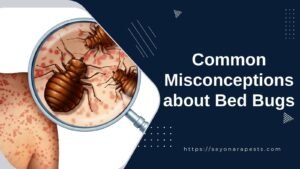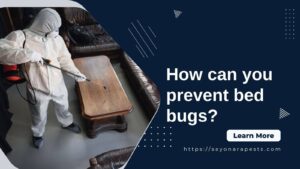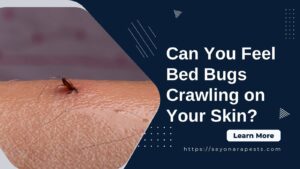Bed Bug Infestations: A Growing Concern
The topic of bed bug infestations is garnering significant attention due to the pests’ impact on public health and their prevalence in various settings, including emergency medical services.
This section delves into the nature of bed bug infestations and their wider implications on society.
Understanding Bed Bug Infestations
Bed bugs are parasitic insects that feed on human blood, often resulting in uncomfortable bites and a number of negative consequences for individuals and communities.
They are known for their resilience and ability to thrive in various environments, which makes them a persistent issue.
These pests have experienced a resurgence in recent years, with notable increases in infestations reported across numerous countries including the United States, Canada, Australia, and the United Kingdom.
The rise in infestations is partly attributed to the ban of the most effective pesticides, such as DDT, in the 1970s due to their toxicity and environmental hazards.
Emergency responders are particularly at risk, as they encounter patients and environments that may harbor bed bugs. It’s crucial for these professionals to be aware, prepared, and equipped with a plan for managing these infestations effectively.
Impact on Public Health
The presence of bed bugs goes beyond mere discomfort; it is a growing public health issue.
The Centers for Disease Control and Prevention (CDC) and the Environmental Protection Agency (EPA) have identified bed bug infestations as a public health pest that can cause negative physical health, mental health, and economic consequences.
It’s important to note that while bed bugs are not known to transmit diseases, their impact on quality of life and well-being is significant.
A study in northeast Ohio highlighted the extent of the problem, demonstrating that bed bugs are one of the most common ectoparasites encountered by healthcare providers in the United States. Moreover, emergency department visits attributed to bed bugs have seen a seven-fold increase between 2007 and 2010, emphasizing the pest’s impact on healthcare settings.
For first responders, the challenge is twofold: they must protect patients and themselves from infestations and address the economic and health repercussions that come with it. As the public becomes more aware of the issue, it’s imperative to explore effective bed bug extermination methods and implement prevention strategies that can mitigate the associated risks.
Factors Contributing to Bed Bug Spread
Understanding the factors contributing to the spread of bed bugs is essential for effective control and eradication. Two primary factors are the resilience of bed bugs and common misconceptions about their behavior and habitats.
Bed Bug Resilience
Bed bugs are notorious for their resilience and ability to survive in various environments. Historically, in the United States, bed bug infestations were widespread until the mid-20th century when the use of DDT nearly eradicated the population. However, it took almost half a century for bed bugs to make a comeback, demonstrating their ability to endure over time (EMS1).
These pests can survive for months without feeding and are capable of withstanding a range of temperatures, from nearly freezing to 122 degrees Fahrenheit.
Their small size allows them to hide in minuscule crevices and their flat bodies enable them to fit into spaces as thin as a credit card. This makes them particularly difficult to detect and eliminate.
To exacerbate the issue, bed bugs can easily hitchhike on clothing, luggage, and other personal belongings, making any public service vehicle like an ambulance vulnerable to infestations.
This is why regular inspections of hidden areas in emergency vehicles are crucial, including checking behind dashboards, inside storage spaces, under floor mats, within medical equipment, and in other concealed spots (Sterifab).
Misconceptions About Bed Bug Infestations
There are several misconceptions about bed bugs that can hinder prevention and control efforts. Contrary to popular belief, bed bug infestations are not caused by poor sanitary conditions and do not reflect a person’s social status or hygiene. These pests are indiscriminate and have been found in a variety of settings, from luxurious homes to public shelters.
Another common misconception is the identification of bed bugs. They are often mistaken for ticks or small cockroaches, but biologically, they are closer to aphids and cicadas.
Their specialized mouthparts are designed for feeding on warm-blooded hosts, making humans a preferred target.
Additionally, many believe that conventional bug repellents or mosquito repellents can deter bed bugs, or that over-the-counter foggers can eliminate an infestation.
However, these methods are generally ineffective against bed bugs. Professional treatment is almost always required to fully eradicate them, highlighting the importance of expertise in dealing with these infestations.
To address these challenges, it is vital to educate oneself on the realities of bed bug behavior and effective elimination techniques.
By dispelling common misconceptions about bed bugs and understanding their resilience, individuals and professionals can take more informed actions to prevent bed bugs from spreading and implement effective bed bug extermination methods.
Challenges of Dealing with Bed Bugs
Addressing bed bug infestations, particularly in environments such as ambulances, presents significant challenges that extend beyond the immediate concern of eradication.
The effects of these infestations can be felt economically as well as on the health and well-being of individuals.
Economic Consequences
The economic repercussions of bed bug infestations are non-trivial, particularly for emergency response services.
Decontaminating an ambulance or a patient room due to a bed bug infestation incurs direct costs that are substantial. For instance, the emergency department’s annual expenditure for decontamination processes can reach approximately $50,000.
This does not account for the indirect costs such as lost service hours, replacement of medical equipment, and potential litigation from affected parties.
Moreover, the presence of bed bugs can lead to decreased productivity among medical personnel due to the time and resources diverted to manage these pests.
The loss in revenue for businesses, such as hotels and rental properties, that must close for treatment, further underscores the economic strain posed by bed bug infestations. It’s clear that bed bugs are not only a nuisance but also a significant financial burden.
Health Risks Associated with Bed Bugs
While bed bugs have not been shown to transmit diseases, they are identified as a public health pest with consequences that extend to physical and mental health.
The bites from these insects can result in a range of dermatological issues, including itching, rash, and allergic reactions. In some cases, repeated exposure to bites may lead to secondary infections.
The psychological impact is also noteworthy. Individuals experiencing bed bug infestations may suffer from anxiety, insomnia, and social stigma. Interestingly, a study revealed that only 18% of bed bug-infested patients reported their condition to emergency medicine providers, potentially due to fear of discrimination or receiving substandard care.
This reluctance to seek help not only undermines effective treatment but also contributes to the silent spread of infestations.
It is critical for emergency response teams to be equipped with knowledge on preventing bed bugs from spreading and to have access to professional bed bug treatment options.
Moreover, public education campaigns are essential to dispel common misconceptions about bed bugs and to encourage individuals to report infestations without fear of judgment.
Those seeking to learn more about bed bug infestations in various settings can explore further information on bed bug infestations in libraries, restaurants, laundromats, and other public spaces. It is through combined efforts in education, prevention, and effective eradication that the challenges posed by bed bugs can be successfully managed.
Effective Methods to Eliminate Bed Bugs
When it comes to tackling bed bug infestations in ambulances or any other environment, there are a few proven methods that can be employed to eliminate these persistent pests effectively.
Here, we will discuss cooling treatments, heating treatments, and chemical solutions, which are considered among the best bed bug elimination techniques.
Cooling Treatments
Cooling treatments involve exposing bed bugs to temperatures at or below 0°F (-19°C) for a sustained period, typically at least four days, as recommended by the Environmental Protection Agency.
However, implementing such cold treatments in larger vehicles like ambulances may be impractical.
For smaller items, placing them in a freezer or an environment with sufficiently low temperatures could be a viable option. Homeowners and renters can consider freezing to kill bed bugs for items such as clothing or small furnishings.
Heating Treatments
Heating treatments are a highly effective method to eradicate bed bugs across all stages of their life cycle, from eggs to adults.
This method involves superheating the infested area using specialized propane or electric heating equipment to temperatures lethal to bed bugs. While this method requires professional expertise and special equipment, it has the advantage of being able to penetrate into crevices where bed bugs may be hiding.
For more information on how to employ this method safely and effectively, visit our page on killing bed bugs with heat.
Chemical Solutions
Chemical treatments can be an effective way to combat bed bug infestations, though they often require the knowledge and experience of a professional exterminator.
Most over-the-counter insect foggers are ineffective against bed bugs, and conventional bug or mosquito repellents do not deter them. Professional exterminators may use a range of chemical solutions, such as insecticides, to address the infestation.
For a comprehensive list of chemical and non-chemical solutions, including bed bug insecticides for eradication and natural remedies for killing bed bugs, you can explore our extensive guide on ways to kill bed bugs.
When considering any of these methods, it’s important to weigh the pros and cons, as well as the practicality of each approach given the setting and scale of the infestation.
Professional advice or services are often necessary to ensure complete elimination of bed bugs, especially in challenging environments like ambulances where health and safety standards must be maintained.
Prevention and Management Strategies
In the battle against bed bug infestations in ambulances, prevention and management strategies are vital tools. These strategies not only protect the health and well-being of first responders and patients but also help maintain the integrity of emergency response services.
Proactive Approach for First Responders
First responders play a critical role in preventing the spread of bed bugs. The National Pest Management Association underscores the importance of developing a robust action plan and ensuring that all medical personnel attend a bed bug awareness and education program.
Here are some key proactive measures for first responders:
- Regularly inspect ambulances and equipment for signs of bed bugs.
- Use protective covers for stretcher mattresses that are impermeable to bed bugs.
- Implement strict protocols for cleaning and disinfecting vehicles and equipment after every transport.
- Educate all personnel on identifying bed bugs and appropriate decontamination procedures.
By maintaining vigilance and adhering to these preventive measures, first responders can significantly reduce the risk of transporting bed bugs to other environments.
Additional tips for preventing bed bugs when traveling can also be adapted for emergency response scenarios.
Public Safety Measures
Public safety leaders must prioritize the implementation of measures to prevent bed bug infestations within first response vehicles and facilities.
Fire stations and other emergency service facilities have faced closures due to bed bug infestations, which can impact service levels and disrupt personnel. Essential public safety measures include:
- Establishing clear guidelines for reporting and managing bed bug sightings.
- Regularly scheduled professional inspections of facilities and vehicles.
- Encouraging collaboration between pest control professionals and public health officials.
- Providing resources and support for first responders to prevent bed bugs from infesting their homes.
Moreover, public education campaigns can inform the community about bed bugs, their risks, and how to prevent infestations. These efforts can help destigmatize the issue and encourage proactive management in places such as hotels and public spaces.
Through proactive approaches and public safety measures, emergency response teams can safeguard their operations from bed bug infestations.
This not only ensures the health and safety of the personnel and patients but also maintains the trust and reliability of emergency medical services. For further guidance on bed bug eradication, explore professional bed bug treatment options and effective bed bug extermination methods.
Educating and Training Personnel
To combat the escalating issue of bed bug infestations in ambulances, educating and training medical personnel is vital. A well-informed team can prevent the spread of these pests and protect the health of both patients and emergency response workers.
Awareness Programs for Medical Personnel
Awareness programs are an essential first step in equipping medical personnel with the knowledge they need to identify and manage bed bug problems.
The National Pest Management Association emphasizes the importance of all medical personnel attending a bed bug awareness and education program. These programs should cover the following topics:
- Identification of bed bugs and signs of an infestation
- Understanding the health risks associated with bed bugs
- Best practices for decontaminating equipment and vehicles
- Personal protective measures to prevent spreading bed bugs to their homes
By incorporating awareness programs into standard training protocols, medical personnel can become adept at recognizing and addressing bed bug issues promptly, thus safeguarding their work environment.
Implementing Action Plans
Implementing action plans involves creating and enforcing a set of procedures to follow in the event of a bed bug discovery. Public safety leaders play a critical role in keeping bed bugs out of first responders’ vehicles and station facilities.
Action plans should include:
- Immediate isolation of infested areas or equipment
- Notification procedures for supervisors and pest control specialists
- Steps for decontamination, such as using steam to kill bed bugs or vacuuming to eliminate bed bugs
- Guidelines for follow-up inspections and ongoing monitoring
A comprehensive action plan ensures that everyone knows their role in the event of an infestation, thus minimizing the risk of spreading bed bugs and maintaining a safe environment for both patients and emergency responders.
By focusing on education and the implementation of structured action plans, EMS agencies can effectively manage and prevent bed bug infestations.
Continuous training and adherence to these strategies are crucial for maintaining the health and safety of both patients and first responders in the face of this growing public health concern.




